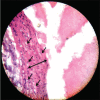Evaluation of Antioxidant, Hypolipidemic, and Antiatherogenic Property of Lycopene and Astaxanthin in Atherosclerosis-induced Rats
- PMID: 28539740
- PMCID: PMC5424557
- DOI: 10.4103/0974-8490.204654
Evaluation of Antioxidant, Hypolipidemic, and Antiatherogenic Property of Lycopene and Astaxanthin in Atherosclerosis-induced Rats
Abstract
Background: Atherosclerosis is one of the major causes of morbidity and mortality in the world. Antioxidants play a major role in prophylaxis and prevention of progression and complications of atherosclerosis.
Objective: In this study, we are evaluating the antiatherosclerotic effect of two antioxidants such as astaxanthin and lycopene.
Materials and methods: After acclimatization, 24 male SD rats, 8-10 weeks old, 150 ± 10 g, maintained as per CPCSEA guidelines were divided into four groups of six rats each. Baseline values of weight lipid profile and 2-Thiobarbituric Acid Reactive Substances (TBARS) assay were taken. All the rats were fed with high cholesterol diet (HCD). HCD only, HCD + atorvastatin (50 mg/kg), HCD + lycopene (50 mg/kg), and HCD + astaxanthin (50 mg/kg) were given to control, standard, lycopene, and astaxanthin groups, respectively, through oral gavage for 45 days. The rats were sacrificed at the end of the study, blood sample collected from aorta, and then aorta was dissected for histopathology.
Results: The lipid profile showed lycopene and astaxanthin decreased total cholesterol, low-density lipoprotein-cholesterol (LDL-C), very LDL-C, and triglycerides and increased high-density lipoprotein-cholesterol level significantly (P < 0.05) compared to the control but less than atorvastatin. The TBARS value of lycopene was significantly lower compared to HCD and atorvastatin groups, whereas astaxanthin was significantly less than HCD group only. The histopathology showed only Type I lesions, no naked fatty streaks, few foam cells in lycopene, and astaxanthin groups compared to control where we observed Type II and III lesions, visible fatty streaks and many foam cells with intimal thickening in HCD group.
Conclusion: In this study, lycopene and astaxanthin showed antioxidant, antihyperlipidemic, and antiatherosclerotic property. This warrants further study for including them in the treatment of atherosclerosis.
Summary: Antioxidants play a major role in prophylaxis and prevention of progression and complications of atherosclerosis.Lycopene and Astaxanthin are suitable candidates for further research in cardiovascular disease and there is paucity of studies evaluating their role in prevention of atherosclerosis.The effect of lycopene and Astaxanthin for anti-atherosclerotic property was evaluated in high cholesterol diet fed rats.The lipid profile showed lycopene and Astaxanthin decreased TC, LDL-C, VLDL-C and triglycerides and increased HDL-C level significantly (P < 0.05) compared to the control but less than atorvastatin.The TBARS value of Lycopene was significantly lower compared to HCD and atorvastatin groups while Astaxanthin was significantly less than HCD group only.The histopathology showed only type I lesions, no naked fatty streaks, few foam cells in lycopene and Astaxanthin groups compared to control.The study proves Lycopene and Astaxanthin have hypolipideamic and anti-atherogenic potential can be included in the treatment of hypercholesterolemia and atherosclerosis. Abbreviations Used: TC: total cholesterol, HDL-C: high density lipoprotein cholesterol, LDL-C: low density lipoprotein cholesterol, VLDL-C: very Low density lipoprotein cholesterol, TG: triglycerides, and TBARS: thiobarbituric acid reactive substances, HCD: high cholesterol diet.
Keywords: Antioxidant; astaxanthin; atherosclerosis; hypercholesterolemia; lycopene.
Conflict of interest statement
There are no conflicts of interest.
Figures






Similar articles
-
Supplementation of whole grain flaxseeds (Linum usitatissimum) along with high cholesterol diet and its effect on hyperlipidemia and initiated atherosclerosis in Wistar albino male rats.Vet World. 2018 Nov;11(10):1433-1439. doi: 10.14202/vetworld.2018.1433-1439. Epub 2018 Oct 17. Vet World. 2018. PMID: 30532498 Free PMC article.
-
Hypolipidemic, antioxidant and anti-atherosclerogenic effect of aqueous extract leaves of Cassia. occidentalis Linn (Caesalpiniaceae) in diet-induced hypercholesterolemic rats.BMC Complement Altern Med. 2017 Jan 25;17(1):76. doi: 10.1186/s12906-017-1566-x. BMC Complement Altern Med. 2017. PMID: 28122565 Free PMC article.
-
The ACAT inhibitor, CI-1011 is effective in the prevention and regression of aortic fatty streak area in hamsters.Atherosclerosis. 1998 Mar;137(1):77-85. doi: 10.1016/s0021-9150(97)00279-7. Atherosclerosis. 1998. PMID: 9568739
-
Pitavastatin: novel effects on lipid parameters.Atheroscler Suppl. 2011 Nov;12(3):277-84. doi: 10.1016/S1567-5688(11)70887-X. Atheroscler Suppl. 2011. PMID: 22152282 Review.
-
Lowering Targeted Atherogenic Lipoprotein Cholesterol Goals for Patients at "Extreme" ASCVD Risk.Curr Diab Rep. 2019 Nov 21;19(12):146. doi: 10.1007/s11892-019-1246-y. Curr Diab Rep. 2019. PMID: 31754844 Review.
Cited by
-
Lycopene as a Natural Antioxidant Used to Prevent Human Health Disorders.Antioxidants (Basel). 2020 Aug 4;9(8):706. doi: 10.3390/antiox9080706. Antioxidants (Basel). 2020. PMID: 32759751 Free PMC article. Review.
-
Functional candesartan loaded lipid nanoparticles for the control of diabetes-associated stroke: In vitro and in vivo studies.Int J Pharm X. 2024 Jan 2;7:100227. doi: 10.1016/j.ijpx.2023.100227. eCollection 2024 Jun. Int J Pharm X. 2024. PMID: 38260917 Free PMC article.
-
The Influence of Diet on MicroRNAs that Impact Cardiovascular Disease.Molecules. 2019 Apr 17;24(8):1509. doi: 10.3390/molecules24081509. Molecules. 2019. PMID: 30999630 Free PMC article. Review.
-
Marine Compounds and Age-Related Diseases: The Path from Pre-Clinical Research to Approved Drugs for the Treatment of Cardiovascular Diseases and Diabetes.Mar Drugs. 2024 May 3;22(5):210. doi: 10.3390/md22050210. Mar Drugs. 2024. PMID: 38786601 Free PMC article. Review.
-
Lycopene in the Prevention of Cardiovascular Diseases.Int J Mol Sci. 2022 Feb 10;23(4):1957. doi: 10.3390/ijms23041957. Int J Mol Sci. 2022. PMID: 35216071 Free PMC article. Review.
References
-
- World Health Organization. The Top 10 Causes of Death. [Last cited on 2015 Sep 25]. Available from: http://www.who.int/mediacentre/factsheets/fs310/en/
-
- Robbins SL, Kumar V, Cotran RS. Robbins and Cotran Pathologic Basis of Disease. 8th ed. Philadelphia, PA: Saunders/Elsevier; 2010. pp. 496–506.
-
- Ramchoun M, Harnafi H, Alem C, Benlyas M, Elrhaffari L, Amrani S. Study on antioxidant and hypolipidemic effects of polyphenol-rich extracts from Thymus vulgaris and Lavandula multifida. Pharmacognosy Res. 2009;1:106–12.
-
- IUPAC Commission on the Nomenclature of Organic Chemistry and the IUPAC-IUB Commission on Biochemical Nomenclature. Nomenclature of carotenoids (rules approved 1974) Pure Appl Chem. 1975;41:405–31.
-
- Di Mascio P, Kaiser S, Sies H. Lycopene as the most efficient biological carotenoid singlet oxygen quencher. Arch Biochem Biophys. 1989;274:532–8. - PubMed
LinkOut - more resources
Full Text Sources
Miscellaneous
